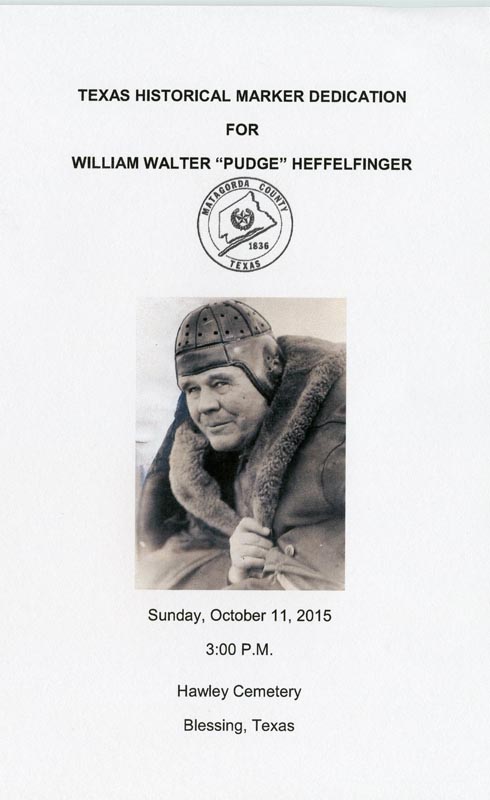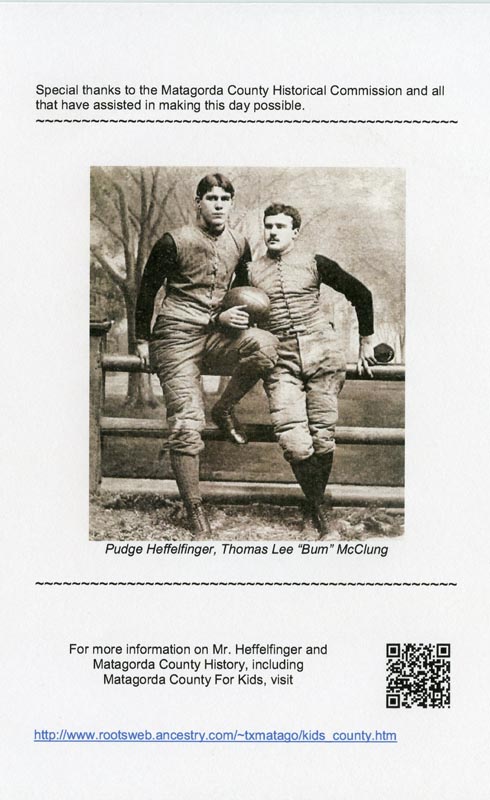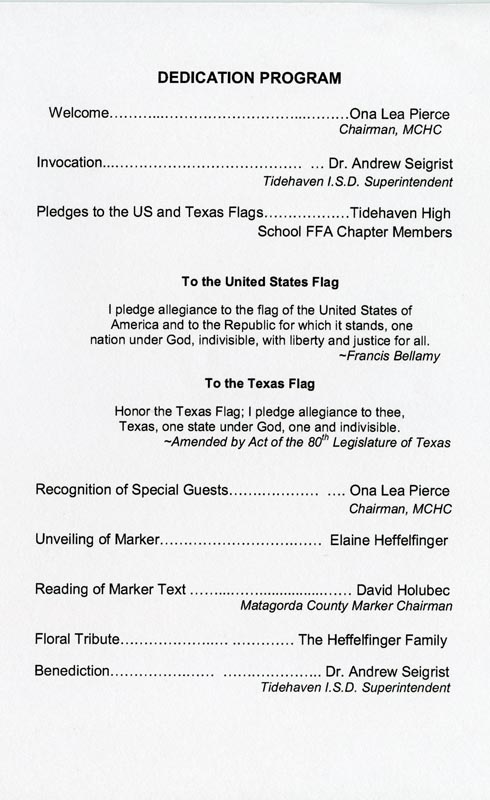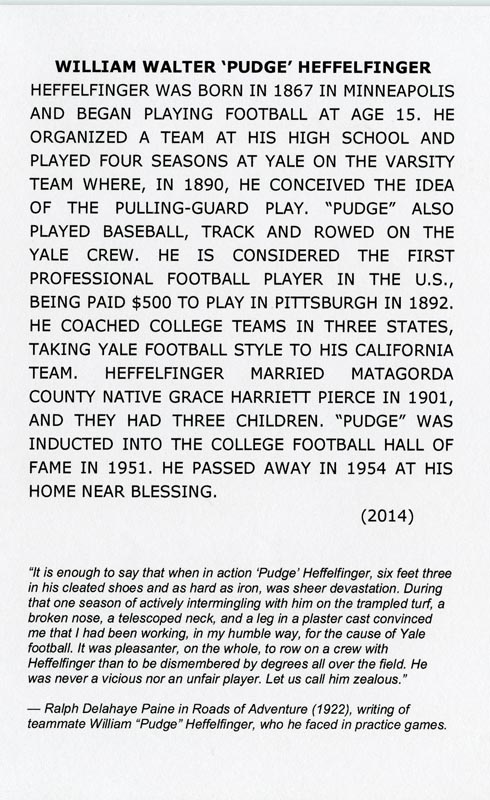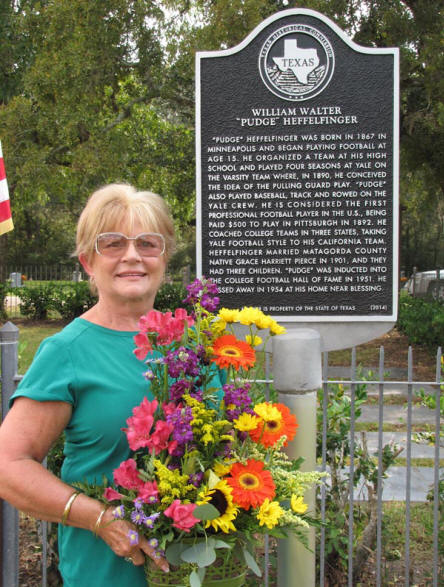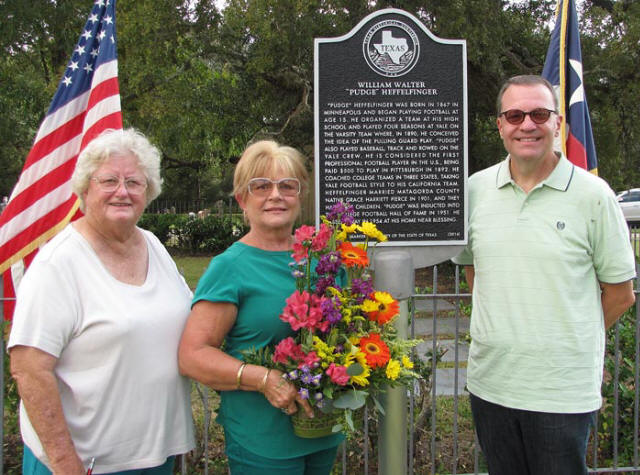| H | William Walter "Pudge" Heffelfinger
First Documented Professional Football Player |
H |
William Walter “Pudge” Heffelfinger
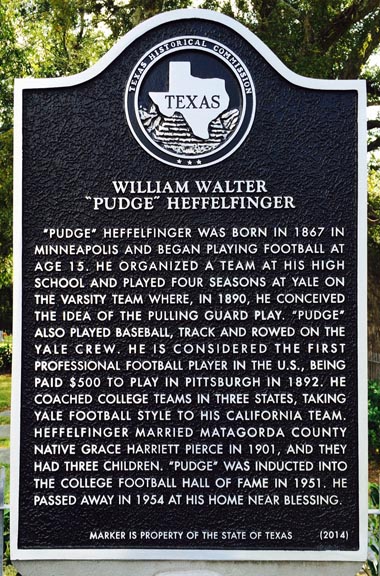 I.
CONTEXT:
I.
CONTEXT:
Baseball is considered, “America’s Pastime,” but fall Friday nights in Texas and around the country have traditionally been reserved for high school football. Entire communities turn out to cheer their teams on to victory and community rivalries have continued for decades. College football games dominate the Saturdays in the fall and professional games are played on weekends and Monday nights. America loves football.
European Rugby made its way across the Atlantic and was played in the United States in the 1800s—primarily in the Ivy League schools. The game of soccer had been played in the early 1800s in the major schools in England and after the Rugby School began playing a carrying game with the use of goal posts, the name of the new version of the game became Rugby.
The birth date of football in the United States is considered to be November 6, 1869 when Rutgers and Princeton met for the first college football game. The first teams had 20 players and few standard rules. The team size was later reduced to 15 and, due to the influence of Yale coach, Walter Camp, to the standard 11.
The Intercollegiate Football Association (IFA) was formed by representatives of Columbia, Rutgers, Princeton and Yale in 1873. At that time the new IFA formulated the first rules for college football. The forward pass became legal, rough mass plays were prohibited, the length of the game was shortened from 70 to 60 minutes and the neutral zone between the teams was established.
It was soon after the formation of the IFA that Pudge Heffelfinger experienced football in 1867 at the age of 15.
II. OVERVIEW:
William Walter “Pudge” Heffelfinger was born December 20, 1867 in Minneapolis, Minnesota and died April 2, 1954 near Blessing in Matagorda County, Texas. His parents were Major Christopher B. Heffelfinger (1834-1915) and Mary Ellen Totton Heffelfinger (1835-1916). His father, a tanner by trade, opened the North Star Shoe Company in Minneapolis the same year Pudge was born and Pudge would later work with his father in the shoe business.
Pudge said of his first experience in football, “I started as a fifteen-year-old schoolboy in my home town of Minneapolis, when Rugby had just been modified to suit our Yank yen for knocking people down.” He attended Central High School in Minneapolis and played baseball. His knowledge of football came from reading about Yale, Harvard and Princeton in Spaulding’s Guide. He organized a team at his high school and taught the game to his schoolmates. During his high school years, he also played several games for the University of Minnesota before the days of the Sanity Code which would regulate the game and player eligibility.
Pudge planned to attend the University of Minnesota, but was approached in May 1888 by a Yale alumnus who convinced him to take the Yale entrance exam and tutored him all summer. The test was passed and he entered Yale in the fall of 1889 as a 21-year-old freshman. Coach Corbin nicknamed him “Heff,” because Heffelfinger was too long, and he played guard for Yale for the next four years.
The first day he tried out for the Yale freshman team, William H. “Pa” Corbin, the captain of the varsity team, was watching the freshman practice. He saw Pudge play, had him try out with the varsity team and offered him a position on the varsity line that day. Pudge played all of his four football seasons on the Yale varsity team. When asked why he was so successful, Pudge replied, “My stance was the secret of my ability to get position on kids bigger than I ever was. I stood up to it! Yes, sir, both on attack and defense I stood more or less erect, knees bent in a slight crouch, body leaning forward from the hips, legs spread about three feet apart, left foot advanced when playing left guard. I hit my man with a shoulder lunge on attack and used my hands to start his head in the direction I wanted to move him.”
Of the four years Pudge played for Yale, seasons 1888 and 1891 were undefeated. In the 13 games of 1888, Yale scored 698 points and their opponents 0. Yale lost only two games during the four years, Pudge played.
In 1890, while sitting on the bench watching a game, he conceived the idea of the “running-guard play,” in which the guard blocked for the ball carrier.
Pudge was chosen for Walter Camp’s All-American team the first three years of the team. His last year at Yale he played every minute of the 13 scheduled games. He also played baseball, tossed the weights in track and rowed on the Yale crew. He lettered in all four sports. He said of football versus rowing, “…football is a sissy sport compared to rowing a four-mile race. I always ran off the field full of pep after a sixty-minute game, but my legs shook as though with palsy at the end of the New London boat race.”
After Pudge’s last college football game with Princeton as a senior, “As Pudge walked off the field, a friend grabbed him by the arm and said: ‘Heff, how does it feel to be through with football forever?’” “If I had had John Paul Jones’ knack for epigrams, I might have answered ‘Me quit football? Why, I’ve only begun to play!’”
Heffelfinger is considered the first documented professional football player in the United States. A Pennsylvania state historical marker near Heinz Field, Pittsburgh, Pennsylvania dedicated on November 2, 1992, chronicles the game in which he first played as a professional.
First Professional Football Game
On November 12, 1892, at Recreation Park a few blocks NW of
here, the Allegheny Athletic Association defeated the Pittsburgh
Athletic Club, 4-0. The winning touchdown was scored by William
("Pudge") Heffelfinger, who received $500 for playing. He was
the first football player known to have been paid outright, and
pro football traces its origin from this game.
The accounting ledger of the Allegheny Athletic Association documents the payment to Heffelfinger. He had previously been offered $250 by the Pittsburgh Athletic Club to play for them, but felt he could not jeopardize his amateur status for that amount.
In 1893, as a coach at the University of California, Berkeley, Heffelfinger introduced the Yale-style of football to the Golden Bears. In 1894 he coached at LeHigh University in Bethlehem, Pennsylvania and the University of Minnesota in Minneapolis in 1895.
Heffelfinger married Grace Harriett Pierce (September 1, 1879 - February 4, 1960) on December 4, 1901 in Kansas City, Kansas where Grace lived with her aunt and uncle, Mamie Pierce Withers (1867-1923) and Henry Withers (1845-1908). Grace was the daughter of Jonathan Edwards Pierce (December 6, 1839 – March 29, 1915) and Nancy “Nannie” Deborah Lacy Pierce (August 11, 1845 – February 15, 1896) and the niece of Abel Head “Shanghai” Pierce (1834-1900). She was born at her parents’ ranch, Rancho Grande, at Deming’s Bridge, Matagorda County. Deming’s Bridge was renamed Hawley and is near present-day Blessing, Texas. The children of Pudge and Grace were: Nancy Pierce Heffelfinger (February 28, 1904 – April 18, 1980), William Walter Heffelfinger, Jr. (December 1, 1906 – April 21, 1969) and Jane Lacy Heffelfinger Winston (January 23, 1908 – February 9, 1960).
Over the next years, Heffelfinger was a Minnesota delegate to the Republican National Convention in 1904 and 1908; worked for the railroad in the western United States; served as WWI draft-board commissioner and Red Cross worker; served as chairman of the Hennepin County, Minnesota County Commissioners 1924-1928 and ran unsuccessfully for the US Congress in 1930.
Life, however, did not interfere with Pudge Heffelfinger’s love for football. In 1916, he played with the Yale team as a coach; played 20 minutes in an charity game in 1922 in Columbus, Ohio at the age of 54 before dislocating his shoulder and played 31 minutes more after the shoulder was snapped back into place to name a few. He was cajoled into playing in a charity game in Minneapolis in 1933 at the age of 64. The advanced ticket sales were low and they needed someone to draw the crowds. There had no football pants in the locker room that would fit him, so he stuffed the pockets of his business suit trousers with towels, pulled on a jersey over his shirt, borrowed a helmet and hit the field with no kidney or knee pads to protect him from players young enough to be his grandsons. After playing for nine minutes, he ended his 50-year football career by voluntarily benching himself.
In 1930, Heffelfinger founded Heffelfinger Publications which produced a sales booklet for football and baseball equipment. In 1935, he began publishing Heffelfinger’s Football Facts which included fundamental principles of the game, statistical facts, 240 collegiate schedules and the scores for the previous year. He was the editor, thus his picture was on the cover. The Football Facts continued publication until 1950 under Heffelfinger Publications, Pearson Advertising Agency, Inc., and Post Publishing Company.
Heffelfinger and his wife, Grace, had divided their time between Minneapolis and Matagorda County after their marriage, but moved to Live Oak Farm, near Blessing, Texas, after the death of Grace’s sister, Pearl Lacy Pierce Smith, in 1939. They made Live Oak Farm their home during the last years of their lives.
He was inducted into the College Football Hall of Fame in 1951 and made his last visit to Yale on November 21, 1953, when he was presented with a certificate naming him as a member of the Football Hall of Fame during halftime at a Yale game.
Heffelfinger collaborated with John McCallum in writing a book about his football memoirs and observations entitled This Was Football, but he died before the book was published. His death occurred on April 2, 1954 at Live Oak Farm at the age of 86 and was buried at Hawley Cemetery near Blessing. His grave is visited periodically by fans who want to pay homage to the “Grandaddy of the Old Blues.”
III. SIGNIFICANCE:
Football influences many aspects of American life from pee wee to professional teams; games across the country involving thousands; televised games; team-sanctioned clothing, shoes, video games and souvenirs; and the popularity of the players.
Pudge Heffelfinger, was a celebrity during his time at Yale and the role he played during football’s infancy continued to make him well-known in football circles for the remainder of his life. His football career intermittently spanned 50 years and he was an ambassador for football during those 50 years.
He formed his high school team; coached college teams in three states and introduced football to his California team. He has inspired football players since his time as a college player and is still well-known to football players of the present.
Professional football is a huge part of American life and as the
first documented football player, Heffelfinger was the
cornerstone.
